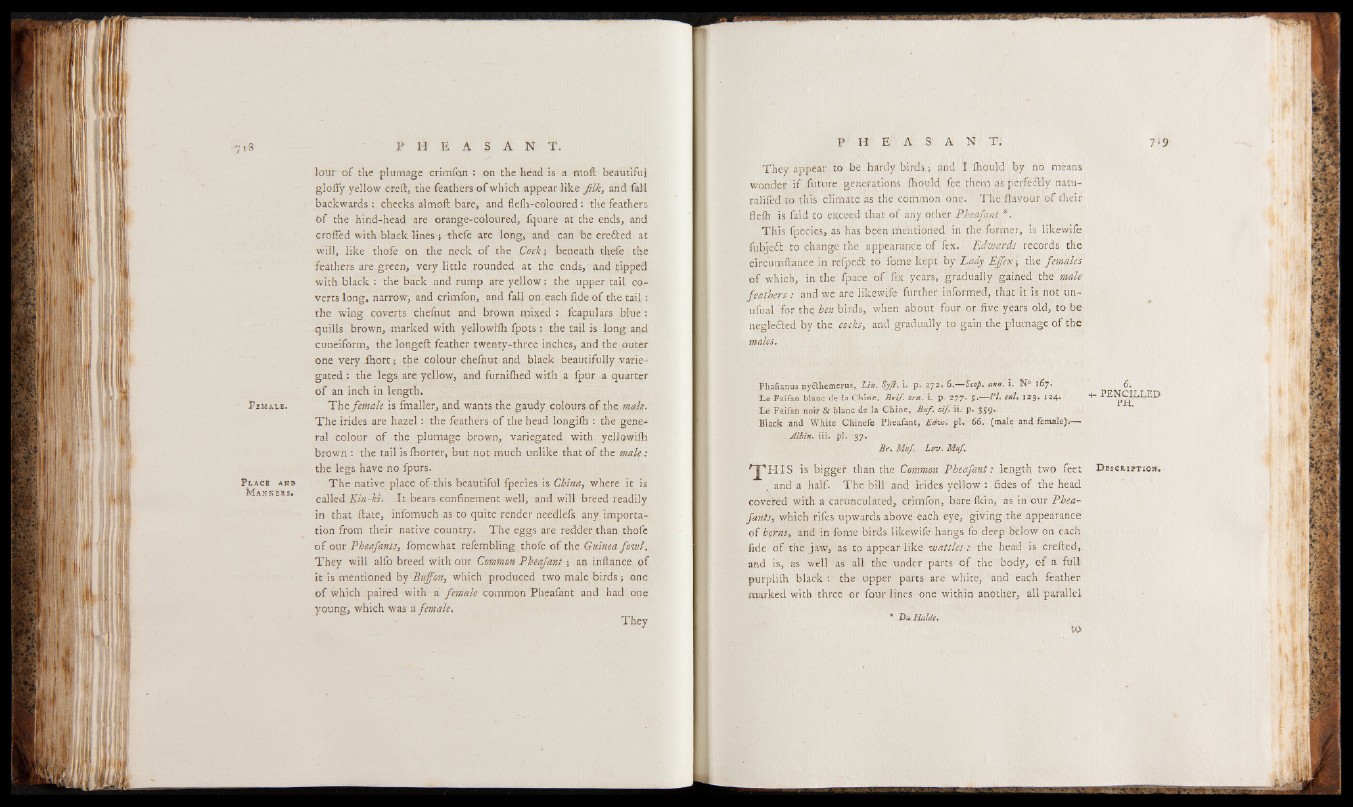
‘ *8 P H E A S A N T .
F emale.
lour of the plumage crimfon : on the head is a mol beautiful
glofly yellow creft, the feathers of which appear like f i lk , and fall
backwards: cheeks almoft bare, and flefh-coloured: the feathers
6f the hind-head are orange-coloured, fquare at the ends, and
croffed with black lines; thefe are long, and can be ere&ed at
will, like thofe on, the neck of the C o c k ; beneath thefe the
feathers are green, very little rounded at the ends, and tipped
with black : the back and rump are yellow: the upper tail coverts
long, narrow, and crimfon, and fall on each fide of the ta il:
the wing coverts chefnut and brown mixed : fcapulars blue :
quills brown, marked with yellowffh fpots; the tail is long and
cuneiform, the longeft feather twenty-three inches, and the outer
one very fhort; the colour chefnut and black beautifully variegated
: the legs are yellow, and furnifhed with a fpur a quarter
of an inch in length.
The. fem ale is fmaller, and wants the gaudy colours of the male.
The irides are hazel: the feathers of the head longifh : thé general
colour of the plumage brown, variegated with yellowifli
brown : the tail is fhorter, but not much unlike that of the male ;
P lace and
Manners.
the legs have no fpurs.
The native place of this beautiful fpecies is China, where it is
called K in -k i. It bears confinement well, and will breed readily
in that ftate, infomueh as to quite render needlefs any importation
from their native country. The eggs are redder than thofe
o f our Pheafants, fomewhat refembling thofe of the Guinea fo w l .
They will alfo breed with our Comtnon P h e a fa n t; an inflance of
it is mentioned by Bujfon, which produced two male birds; one
of which paired with a fem ale common Pheafant and had one
young, which was a female-.
They
They appear to be hardy birds; and I fhoujd by no means
wonder if future generations fhotild fee them as perfeftly natu-
ralifed to this climate as the common one. The flavour of their
flefh is faid to exceed that of any other Pheafant *.
This fpecies, as has been mentioned in the former, is likewife
fubjeft to change the .appearance of fex. Edwards records the
circumftance in refpeft. to fome kept by Lady EJfex; the females
of which, in the fpace of fix years, gradually gained the male
feathers : and we are likewife further informed, that it is not un-
ufual for the hen birds, when about four or. five years old, to be
neglefted by the cocks, and gradually to gain the plumage of the
males.
Phaßanus nyfthemerus, Lin. Syß. x. p. 272. 6.— Scop. anx. i. N° 167.
Le Faifan blanc de la Chine, Brif. orn. i. p. 277. 5 — PI. exl. 123. 124.
Le Faifan noir & blanc de la Chine, Buf. oif. ii. p. 3 5 9 *
Black and White Chinefe Pheafant, E<hu. pi. 66. (male and female);—
Albin. iii. pi. 37.
Br. Muf. Lev. Muf.
is bigger than the Common Pheafant: length two feet
and a half. The bill and irides yellow : fides of the head
covered with a carunculated, crimfon, bare Ikin, as in our Phea-
fants, which rifes upwards above each eye, giving the appearance
of horns, and in fome birds likewife hangs fo deep below on each
fide of the jaw, as to appear like wattles.- the head is crefted,
and is, as well as all the under parts of the body, of a full
purplith black : the upper parts are white, and each feather
marked with three or four lines one within another, all parallel
6.
PENCILLED PH.
D escription.